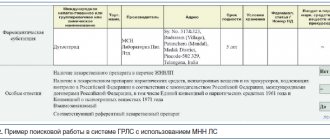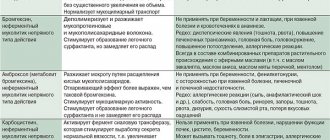Instructions:
Clinical and pharmacological group
01.040 (Diuretic)
pharmachologic effect
"Loop" diuretic. It disrupts the reabsorption of sodium and chloride ions in the thick segment of the ascending loop of Henle. Due to an increase in the release of sodium ions, a secondary (mediated by osmotically bound water) increased excretion of water and an increase in the secretion of potassium ions occurs in the distal part of the renal tubule. At the same time, the excretion of calcium and magnesium ions increases.
It has secondary effects due to the release of intrarenal mediators and redistribution of intrarenal blood flow. During the course of treatment, the effect does not weaken.
In heart failure, it quickly leads to a decrease in preload on the heart by dilating large veins. It has a hypotensive effect due to an increase in the excretion of sodium chloride and a decrease in the response of vascular smooth muscles to vasoconstrictor effects and as a result of a decrease in blood volume. The effect of furosemide after intravenous administration occurs within 5-10 minutes; after oral administration - after 30-60 minutes, maximum effect - after 1-2 hours, duration of effect - 2-3 hours (with reduced kidney function - up to 8 hours). During the period of action, the excretion of sodium ions increases significantly, however, after its cessation, the excretion rate decreases below the initial level (the “ricochet” or “oricochet” syndrome when taken once a day may not have a significant effect on the daily excretion of sodium ions and blood pressure. When / when administered, causes dilatation of peripheral veins, reduces preload, reduces left ventricular filling pressure and pulmonary artery pressure, as well as systemic blood pressure.
The diuretic effect develops 3-4 minutes after IV administration and lasts 1-2 hours; after oral administration - after 20-30 minutes, lasts up to 4 hours.
Pharmacokinetics
After oral administration, absorption is 60-70%. In severe kidney disease or chronic heart failure, the degree of absorption decreases.
Vd is 0.1 l/kg. Binding to plasma proteins (mainly albumin) is 95-99%. Metabolized in the liver. Excreted by the kidneys - 88%, with bile - 12%. T1/2 in patients with normal renal and liver function is 0.5-1.5 hours. With anuria, T1/2 can increase to 1.5-2.5 hours, with combined renal and liver failure - up to 11-20 hours.
Dosage
They are set individually, depending on the indications, clinical situation, and age of the patient. During treatment, the dosage regimen is adjusted depending on the magnitude of the diuretic response and the dynamics of the patient's condition.
When taken orally, the initial dose for adults is 20-80 mg/day, then, if necessary, the dose is gradually increased to 600 mg/day. For children, a single dose is 1-2 mg/kg.
The maximum oral dose for children is 6 mg/kg.
With intravenous (jet) or intramuscular administration, the dose for adults is 20-40 mg 1 time / day, in some cases - 2 times / day. For children, the initial daily dose for parenteral use is 1 mg/kg.
Drug interactions
When used simultaneously with aminoglycoside antibiotics (including gentamicin, tobramycin), nephro- and ototoxic effects may be enhanced.
Furosemide reduces the clearance of gentamicin and increases plasma concentrations of gentamicin and tobramycin.
When used simultaneously with cephalosporin antibiotics, which can cause renal dysfunction, there is a risk of increased nephrotoxicity.
When used simultaneously with beta-agonists (including fenoterol, terbutaline, salbutamol) and corticosteroids, hypokalemia may increase.
When used simultaneously with hypoglycemic agents and insulin, the effectiveness of hypoglycemic agents and insulin may decrease, because furosemide has the ability to increase plasma glucose levels.
When used simultaneously with ACE inhibitors, the antihypertensive effect is enhanced. Severe arterial hypotension is possible, especially after taking the first dose of furosemide, apparently due to hypovolemia, which leads to a transient increase in the hypotensive effect of ACE inhibitors. The risk of renal dysfunction increases and the development of hypokalemia cannot be excluded.
When used simultaneously with furosemide, the effects of non-depolarizing muscle relaxants are enhanced.
When used simultaneously with indomethacin and other NSAIDs, the diuretic effect may be reduced, apparently due to inhibition of prostaglandin synthesis in the kidneys and sodium retention in the body under the influence of indomethacin, which is a nonspecific COX inhibitor; decrease in antihypertensive effect.
It is believed that furosemide interacts with other NSAIDs in a similar way.
When used simultaneously with NSAIDs, which are selective COX-2 inhibitors, this interaction is much less pronounced or practically absent.
When used simultaneously with astemizole, the risk of developing arrhythmia increases.
When used simultaneously with vancomycin, oto- and nephrotoxicity may increase.
When used simultaneously with digoxin and digitoxin, an increase in the toxicity of cardiac glycosides is possible, associated with the risk of developing hypokalemia while taking furosemide.
There are reports of the development of hyponatremia when used simultaneously with carbamazepine.
When used simultaneously with cholestyramine and colestipol, the absorption and diuretic effect of furosemide decreases.
When used simultaneously with lithium carbonate, the effects of lithium may be enhanced due to an increase in its concentration in the blood plasma.
When used simultaneously with probenecid, the renal clearance of furosemide decreases.
When used simultaneously with sotalol, hypokalemia and the development of ventricular arrhythmias are possible.
When used simultaneously with theophylline, a change in the concentration of theophylline in the blood plasma is possible.
When used simultaneously with phenytoin, the diuretic effect of furosemide is significantly reduced.
After intravenous administration of furosemide during therapy with chloral hydrate, increased sweating, a feeling of heat, instability of blood pressure, and tachycardia are possible.
When used simultaneously with cisapride, hypokalemia may increase.
It is assumed that furosemide may reduce the nephrotoxic effect of cyclosporine.
When used simultaneously with cisplatin, the ototoxic effect may be enhanced.
Use during pregnancy and lactation
During pregnancy, the use of furosemide is possible only for a short time and only when the expected benefit of therapy for the mother outweighs the potential risk to the fetus.
Since furosemide can be excreted in breast milk and also suppress lactation, if use during lactation is necessary, breastfeeding should be discontinued.
Side effects
From the cardiovascular system: decreased blood pressure, orthostatic hypotension, collapse, tachycardia, arrhythmias, decreased blood volume.
From the central nervous system and peripheral nervous system: dizziness, headache, myasthenia gravis, calf muscle cramps (tetany), paresthesia, apathy, adynamia, weakness, lethargy, drowsiness, confusion.
From the senses: visual and hearing impairment.
From the digestive system: loss of appetite, dry mouth, thirst, nausea, vomiting, constipation or diarrhea, cholestatic jaundice, pancreatitis (exacerbation).
From the genitourinary system: oliguria, acute urinary retention (in patients with prostatic hypertrophy), interstitial nephritis, hematuria, decreased potency.
From the hematopoietic system: leukopenia, thrombocytopenia, agranulocytosis, aplastic anemia.
From the side of water and electrolyte metabolism: hypovolemia, dehydration (risk of thrombosis and thromboembolism), hypokalemia, hyponatremia, hypochloremia, hypocalcemia, hypomagnesemia, metabolic alkalosis.
Metabolic: hypovolemia, hypokalemia, hyponatremia, hypochloremia, hypokalemic metabolic alkalosis (as a consequence of these disorders - arterial hypotension, dizziness, dry mouth, thirst, arrhythmia, muscle weakness, cramps), hyperuricemia (with possible exacerbation of gout), hyperglycemia .
Allergic reactions: purpura, urticaria, exfoliative dermatitis, exudative erythema multiforme, vasculitis, necrotizing angiitis, itching, chills, fever, photosensitivity, anaphylactic shock.
Other: with intravenous administration (additionally) - thrombophlebitis, renal calcification in premature infants.
Indications
Edema syndrome of various origins, incl. for chronic heart failure stage II-III, liver cirrhosis (portal hypertension syndrome), nephrotic syndrome. Pulmonary edema, cardiac asthma, cerebral edema, eclampsia, forced diuresis, severe arterial hypertension, some forms of hypertensive crisis, hypercalcemia.
Contraindications
Acute glomerulonephritis, urethral stenosis, stone obstruction of the urinary tract, acute renal failure with anuria, hypokalemia, alkalosis, precomatous states, severe liver failure, hepatic coma and precoma, diabetic coma, precomatous states, hyperglycemic coma, hyperuricemia, gout, decompensated mitral or aortic stenosis, hypertrophic obstructive cardiomyopathy, increased central venous pressure (more than 10 mm Hg), arterial hypotension, acute myocardial infarction, pancreatitis, impaired water and electrolyte metabolism (hypovolemia, hyponatremia, hypokalemia, hypochloremia, hypocalcemia, hypomagnesemia), digitalis intoxication, hypersensitivity to furosemide.
special instructions
Use with caution in prostatic hyperplasia, SLE, hypoproteinemia (risk of developing ototoxicity), diabetes mellitus (decreased glucose tolerance), with stenotic atherosclerosis of the cerebral arteries, against the background of long-term therapy with cardiac glycosides, in elderly patients with severe atherosclerosis, pregnancy (especially first half), lactation period.
Before starting treatment, electrolyte disturbances should be compensated. During treatment with furosemide, it is necessary to monitor blood pressure, levels of electrolytes and glucose in the blood serum, liver and kidney function.
To prevent hypokalemia, it is advisable to combine furosemide with potassium-sparing diuretics. With the simultaneous use of furosemide and hypoglycemic drugs, dose adjustment of the latter may be required.
It is not recommended to mix furosemide solution in the same syringe with any other drugs.
Impact on the ability to drive vehicles and operate machinery
When using furosemide, the possibility of a decrease in the ability to concentrate cannot be ruled out, which is important for people driving vehicles and working with machinery.
Preparations containing FUROSEMIDE
• FUROSEMIDE solution for injection. 20 mg/2 ml: amp. 10 pieces. • FUROSEMIDE solution for injection. 20 mg/2 ml: amp. 10 pieces. • FUROSEMIDE solution for injection. 20 mg/2 ml: amp. 10 pieces. • FUROSEMIDE solution for injection. 1% (20 mg/2 ml): amp. 10 pieces. • FUROSEMIDE-FEREIN tab. 40 mg: 50 pcs. • FUROSEMIDE-ROS tab. 40 mg: 50 pcs. • FUROSEMID tab. 40 mg: 10, 50, 3000 or 10000 pcs. • FUROSEMIDE tab. 40 mg: 50 pcs. • FUROSEMIDE solution for intravenous and intramuscular administration 20 mg/2 ml: amp. 5 or 10 pcs. • FUROSEMID tab. 40 mg: 50 pcs. • FUROSEMIDE solution for intravenous and intramuscular administration 20 mg/2 ml: amp. 10 pieces. • FUROSEMIDE solution for injection. 1% (20 mg/2 ml): amp. 10 pieces. • FUROSEMIDE-TEVA tab. 40 mg: 50 pcs. • FUROSEMIDE tab. 40 mg: 50 pcs. • FUROSEMIDE solution for injection. 1% (20 mg/2 ml): amp. 10 pieces. • FUROSEMIDE tab. 40 mg: 10, 20, 25, 30, 40, 50, 75, 100, 125, 5000, 7500 or 10000 • FUROSEMIDE solution for intravenous and intramuscular administration 20 mg/2 ml: amp. 1, 5 or 10 pcs. • FUROSEMIDE-VIAL solution for intravenous and intramuscular administration 20 mg/2 ml: amp. 10 pieces. • FUROSEMIDE tab. 40 mg: 10, 30 and 50 pcs. • FUROSEMIDE tab. 40 mg: 10, 20 or 50 pcs. • FUROSEMID tab. 40 mg: 50 pcs. • FUROSEMIDE solution for injection. 20 mg/2 ml: amp. 10 pieces. • FUROSEMIDE solution for intravenous and intramuscular administration 20 mg/2 ml: amp. 10 pieces. • FUROSEMIDE tab. 40 mg: 50 pcs. • FUROSEMID tab. 40 mg: 50 pcs. • FUROSEMIDE-VIAL solution for intravenous and intramuscular administration 20 mg/2 ml: amp. 10, 100 or 1800 pcs. (packaged by Ozone LLC). • LASIX® (LASIX®) solution for intravenous and intramuscular administration 20 mg/2 ml: amp. 10 pieces. • FUROSEMIDE tab. 40 mg: 50 pcs. • FUROSEMID tab. 40 mg: 50 pcs. • LASIX® tab. 40 mg: 45 or 50 pcs. • FUROSEMID tab. 40 mg: 50 pcs. • FUROSEMIDE tab. 40 mg: 50 pcs. • FUROSEMIDE tab. 40 mg: 10, 20, 30 or 50 pcs. • FUROSEMIDE solution for injection. 1% (20 mg/2 ml): amp. 10 pieces. • FUROSEMIDE solution for injection. 1% (20 mg/2 ml): amp. 10 pieces. • FUROSEMIDE solution for intravenous and intramuscular administration 20 mg/2 ml: amp. 5 or 10 pcs. • FUROSEMID tab. 40 mg: 50 pcs. • FUROSEMIDE solution for injection. 1% (20 mg/2 ml): amp. 10 pieces.
Furosemide
Combinations not recommended
- Chloral hydrate - intravenous infusion of furosemide within a 24-hour period after administration of chloral hydrate can lead to flushing of the skin, profuse sweating, anxiety, nausea, increased blood pressure and tachycardia. Therefore, the use of furosemide in combination with chloral hydrate is not recommended.
- Aminoglycosides - slowing down the excretion of aminoglycosides by the kidneys when used simultaneously with furosemide and increasing the risk of developing ototoxic and nephrotoxic effects of aminoglycosides. For this reason, the use of this combination of drugs should be avoided, except in cases where it is necessary for health reasons, in which case an adjustment (reduction) of maintenance doses of aminoglycosides is required.
Combinations that should be used with caution
- Ototoxic drugs - furosemide potentiates their ototoxicity. Such drugs can be used simultaneously with Furosemide only for strict medical indications, since combined use can lead to irreversible damage to the hearing organ.
- Cisplatin - when used simultaneously with furosemide, there is a risk of ototoxicity. In addition, the nephrotoxic effect of cisplatin may be enhanced when furosemide is used for forced diuresis during treatment with cisplatin, unless furosemide is used in a low dose (for example, 40 mg in patients with normal renal function) and without combination with appropriate hydration of the patient.
- Sucralfate - decreases the absorption of furosemide when taken orally and weakens its effect (furosemide and sucralfate when taken orally should be taken at least two hours apart).
- Lithium salts - under the influence of furosemide, the excretion of lithium is reduced, due to which the content of lithium in the blood serum increases, which increases the risk of its toxic effects, including cardiotoxic and neurotoxic effects. Therefore, when using this combination, monitoring of lithium levels in the blood serum is required.
- Angiotensin-converting enzyme (ACE) inhibitors and angiotensin II receptor antagonists - the use of ACE inhibitors or angiotensin II receptor antagonists in patients previously treated with furosemide may lead to an excessive decrease in blood pressure with deterioration of renal function, and in some cases - to the development of acute renal disease insufficiency, therefore, 3 days before starting treatment or increasing the dose of ACE inhibitors or angiotensin II receptor antagonists, it is recommended to discontinue furosemide or reduce its dose.
- Risperidone - caution should be exercised, carefully weighing the balance of risk and benefit, before deciding to use a combination of risperidone with furosemide or other strong diuretics, as an increase in mortality was observed in elderly patients with dementia receiving concomitant treatment with risperidone and furosemide.
- Levothyroxine-furosemide in high doses can inhibit the binding of thyroid hormones to carrier proteins and thus lead initially to a transient increase in the concentrations of free thyroid hormones, and then, overall, to a decrease in the total concentration of thyroid hormones. When using this combination, thyroid hormone concentrations should be monitored.
Interactions to Consider
- Nonsteroidal anti-inflammatory drugs (NSAIDs) - NSAIDs, including acetylsalicylic acid, may reduce the diuretic effect of furosemide. In patients with hypovolemia and dehydration (including while taking Furosemide), NSAIDs can cause the development of acute renal failure. Furosemide may increase the toxicity of salicylates.
- Phenytoin - decreases the diuretic effect of furosemide.
- Glucocorticosteroids, carbenoxolone, licorice preparations in large quantities and prolonged use of laxatives when combined with furosemide increase the risk of developing hypokalemia.
- Cardiac glycosides, drugs that cause prolongation of the QT interval - if water-electrolyte imbalances (hypokalemia or hypomagnesemia) develop during the use of furosemide, the toxic effect of cardiac glycosides and drugs increases. causing prolongation of the QT interval (the risk of developing heart rhythm disturbances increases).
- Antihypertensives, diuretics or other drugs that can lower blood pressure - when combined with furosemide, a more pronounced decrease in blood pressure is possible.
- Probenecid, methotrexate or other drugs that, like furosemide, are excreted in the renal tubules, can reduce the effects of furosemide (same route of renal excretion); on the other hand, furosemide may lead to decreased renal excretion of these drugs. All this increases the risk of developing HP both with furosemide and the above-mentioned medications taken simultaneously with it.
- Hypoglycemic agents (both for oral administration and insulin preparations), pressor amines (epinephrine, norepinephrine) - weakening of effects when combined with furosemide.
- Theophylline, diazoxide, curare-like muscle relaxants - enhanced effects when combined with furosemide.
- Medicines with nephrotoxic effects - when combined with furosemide, the risk of developing their nephrotoxic effect increases.
- High doses of some cephalosporins (excreted primarily by the kidneys) - in combination with furosemide, the risk of nephrotoxicity of cephalosporins increases.
- Cyclosporine A - when combined with furosemide, the risk of developing gouty arthritis increases due to hyperuricemia caused by furosemide and impaired renal urate excretion under the influence of cyclosporine.
- Radiocontrast agents - in patients at high risk of developing nephropathy due to the administration of radiocontrast agents who were treated with furosemide, there was a higher incidence of renal dysfunction after administration of radiocontrast agents, compared with patients with a high risk of developing nephropathy due to the administration of radiocontrast agents who before administration of radiocontrast agents. X-ray contrast agent was administered only by intravenous fluid administration (hydration).








